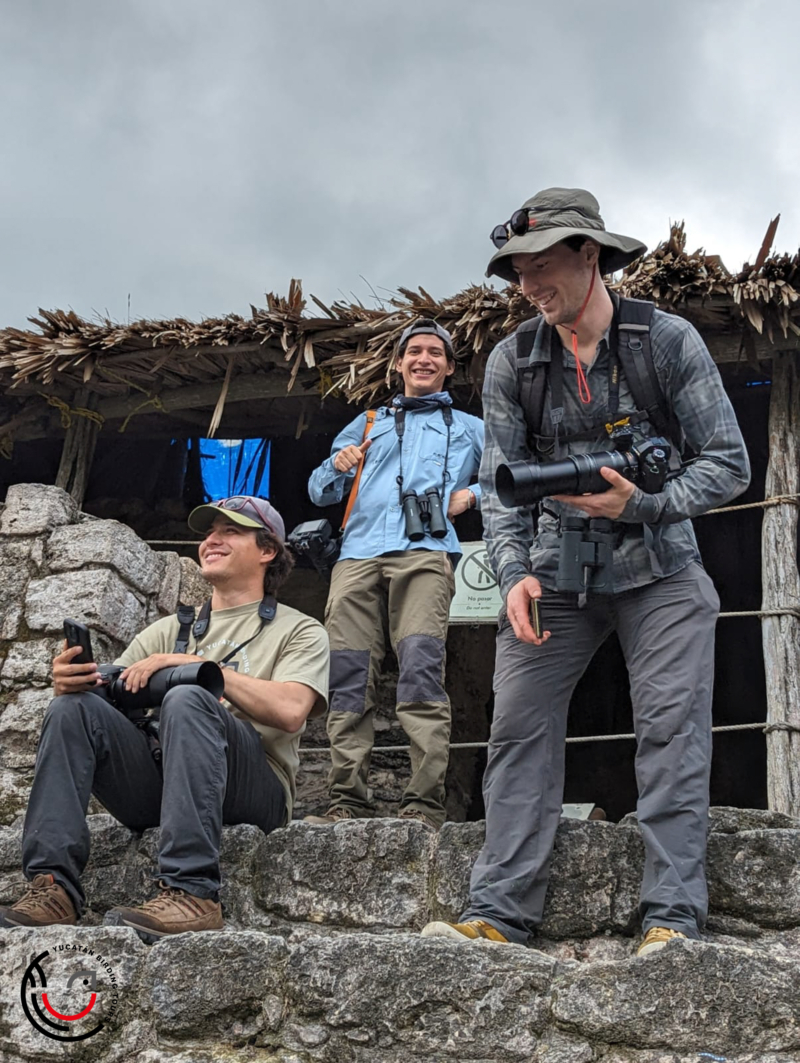Five Day Birding Tour - February 2024
This fun adventure was designed for our friends Kent and Blake Ross, who came from Canada for their first birding and nature photography trip to Mexico.
Day 1.
Our trip started in Mérida, where we picked up Kent and Blake at their hotel and did a short 20 minute drive to the Misnebalam road, to start looking for endemic and Mexican birds. After spending a little more than two hours, we picked up 53 species. Highlights included: Red-billed Pigeon, Ruddy Ground Dove, Groove-billed Ani, Canivet’s Emerald, Cinnamon Hummingbird, Western Cattle Egret, Black Vulture, Roadside Hawk, Ferruginous Pygmy-Owl, Turquoise-browed Motmot, Yucatan Woodpecker, American Kestrel, White-fronted Parrot, Olive-throated Parakeet, Rose-throated Becard, Northern Beardless-Tyrannulet, Yucatan Flycatcher, Boat-billed Flycatcher, Rufous-browed Peppershrike, Mangrove Vireo, Green Jay, Yucatan Jay, Yucatan Gnatcatcher, Tropical Mockingbird, Orange Oriole, Bronzed Cowbird, Gray-crowned Yellowthroat, Palm Warbler, Indigo Bunting and Cinnamon-bellied Saltator.
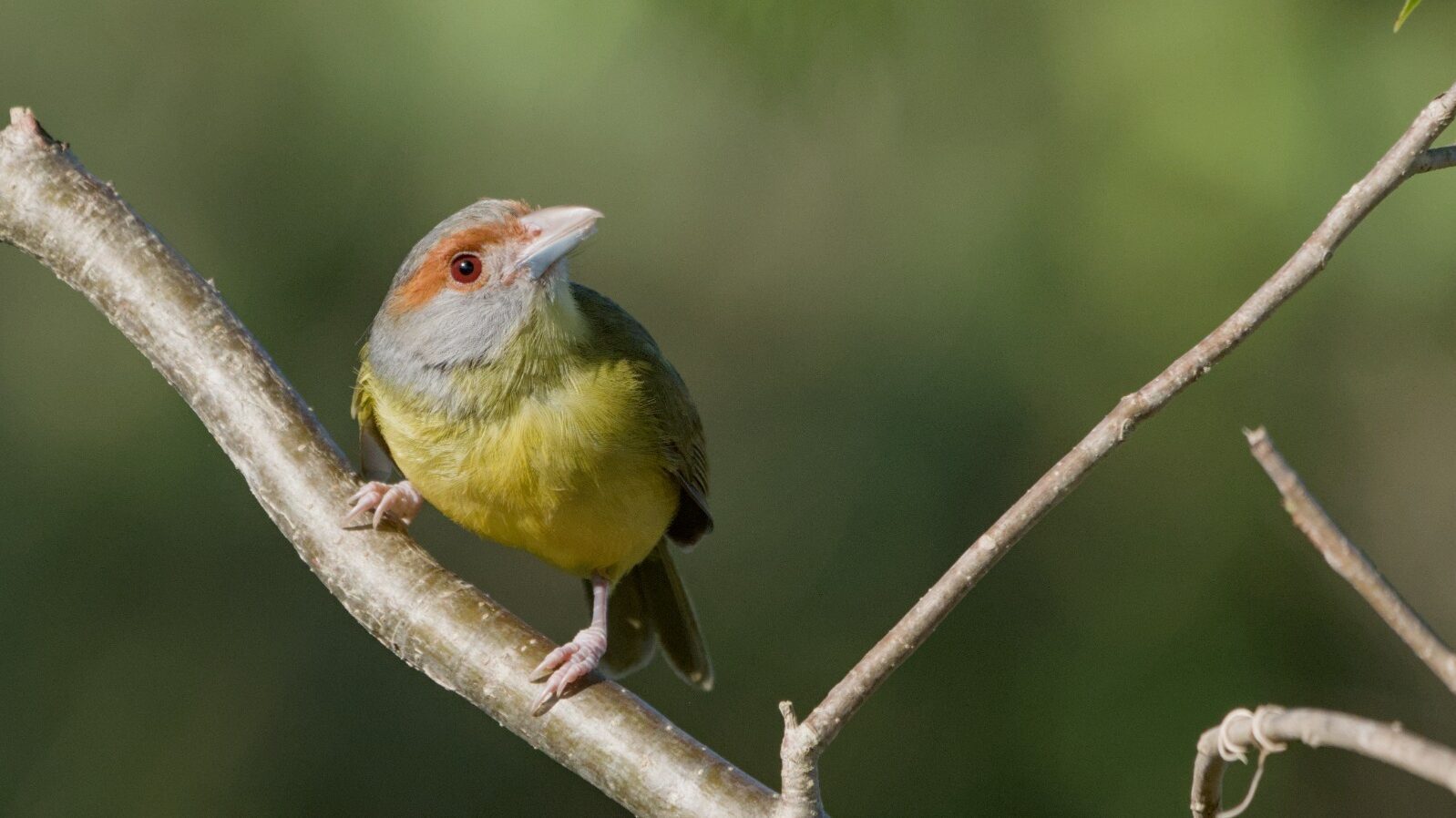
Rufous-browed Peppershrike (Cyclarhis gujanensis) at Misnebalam. Photo by Kent Ross.
After that, we drove for a little bit more to hit the coast, visiting a road in a really productive mangrove area and even though we started birding here at 9:00 AM, we still managed to see 55 bird species including: Blue-winged Teal, American Flamingo, Zenaida Dove, Groove-billed Ani, Black-necked Stilt, American Avocet, Black-bellied Plover, Short-billed Dowitcher, Lesser Yellowlegs, Greater Yellowlegs, Laughing Gull, Forster’s Tern, Sandwich Tern, Wood Stork, Neotropic Cormorant, American White Pelican, Brown Pelican, Tricolored Heron, Snowy Egret, Green Heron, Great Egret, White Ibis, Lesser Yellow-headed Vulture, Great Black Hawk, Belted Kingfisher, Barred Antshrike, Dusky-capped Flycatcher, Tree Swallow, Yucatan Gnatcatcher, Yucatan Wren, Red-winged Blackbird, Northern Waterthrush and Yellow Warbler.
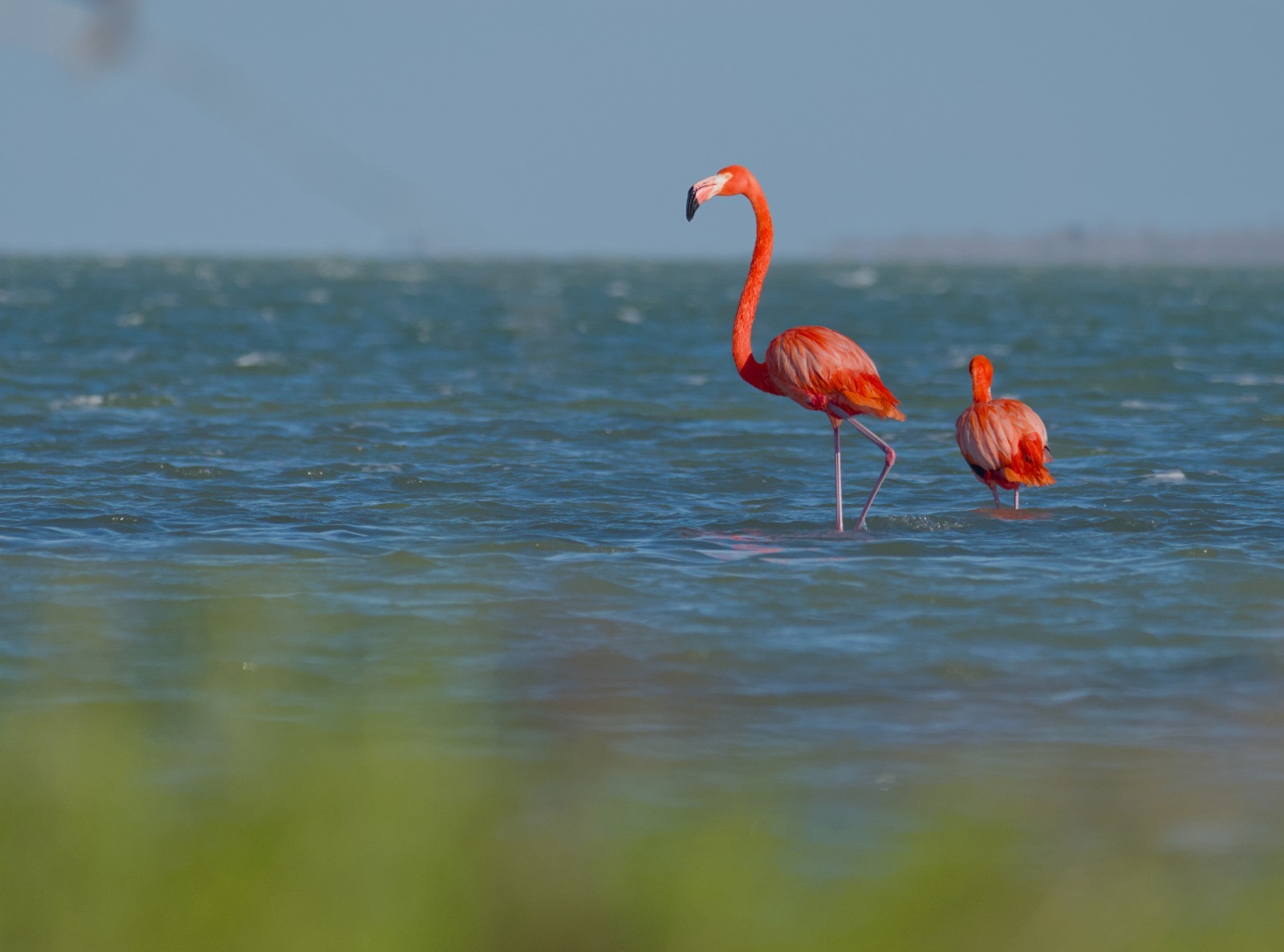
American Flamingo (Phoenicopterus ruber). Photo by Blake Ross.
Right after our visit to the coast, we went back to Merida to check one ecological park where bird activity had been good lately. Our main target was a roosting Northern Potoo, which we indeed found plus other 33 bird species including: Turquoise-browed Motmot, Yucatan Woodpecker, Brown-crested Flycatcher, Tropical Kingbird, Yellow-throated Vireo, Orchard Oriole, Hooded Oriole, Common Yellowthroat, Northern Parula, Yellow-rumped Warbler, Summer Tanager, Blue Grosbeak, Indigo Bunting, Painted Bunting and Cinnamon-bellied Saltator.
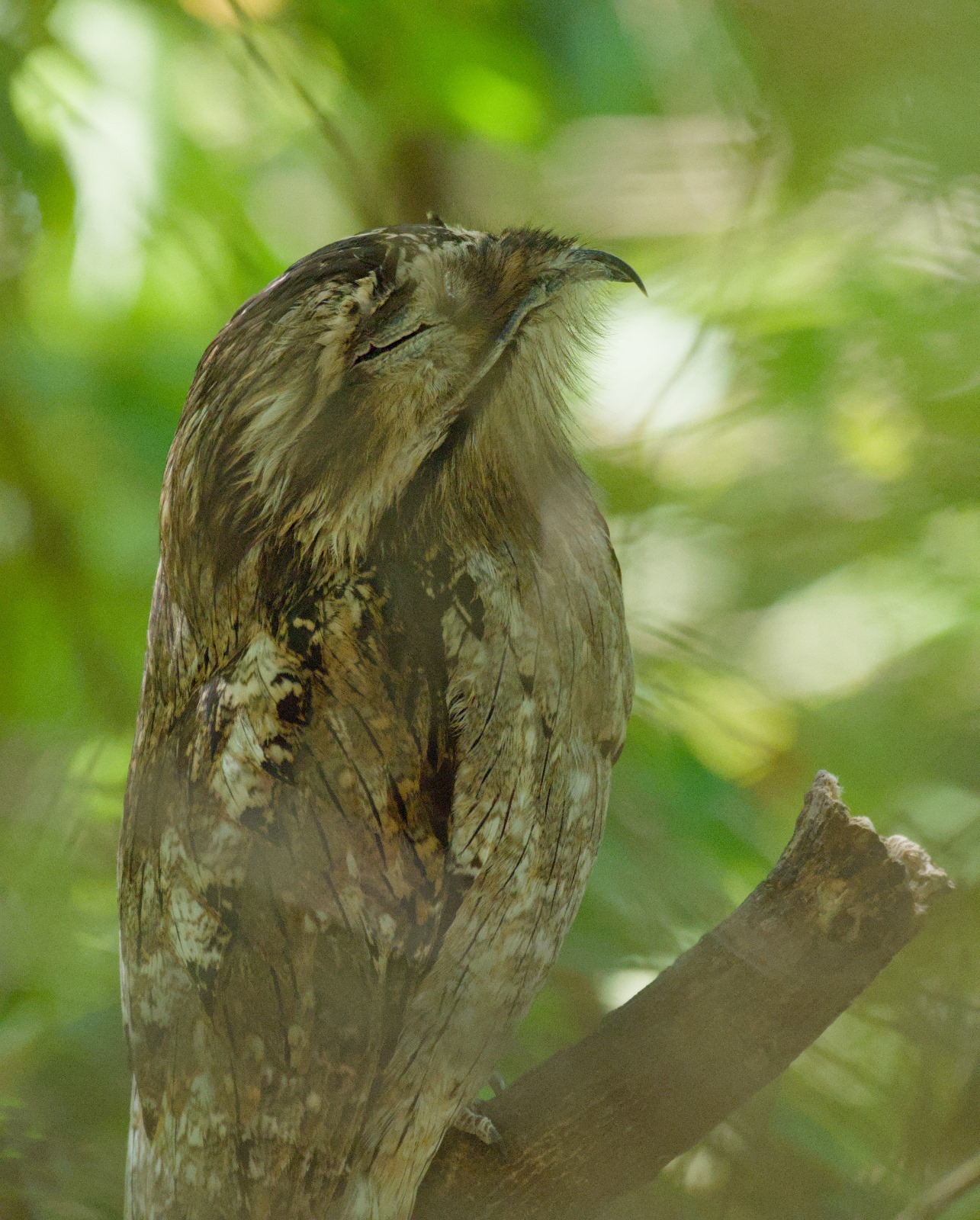
Northern Potoo (Nyctibius jamaicensis). Photo by Blake Ross.
Then, we took a break during the hottest part of the day and went out again in the afternoon to visit another ecological park with a big pond. Highlights from our visit to the ecological park included: Black-bellied Whistling-Duck, Ring-necked Duck, Least Grebe, Pied-billed Grebe, Vaux’s Swift, Common Gallinule, American Coot, Limpkin, Northern Jacana, Solitary Sandpiper, Anhinga, Neotropic Cormorant, Green Heron, Snail Kite, Gray Hawk, Great Kiskadee, Couch’s Kingbird, House Wren, Clay-colored Thrush, Yellow-throated Warbler and Blue-gray Tanager.
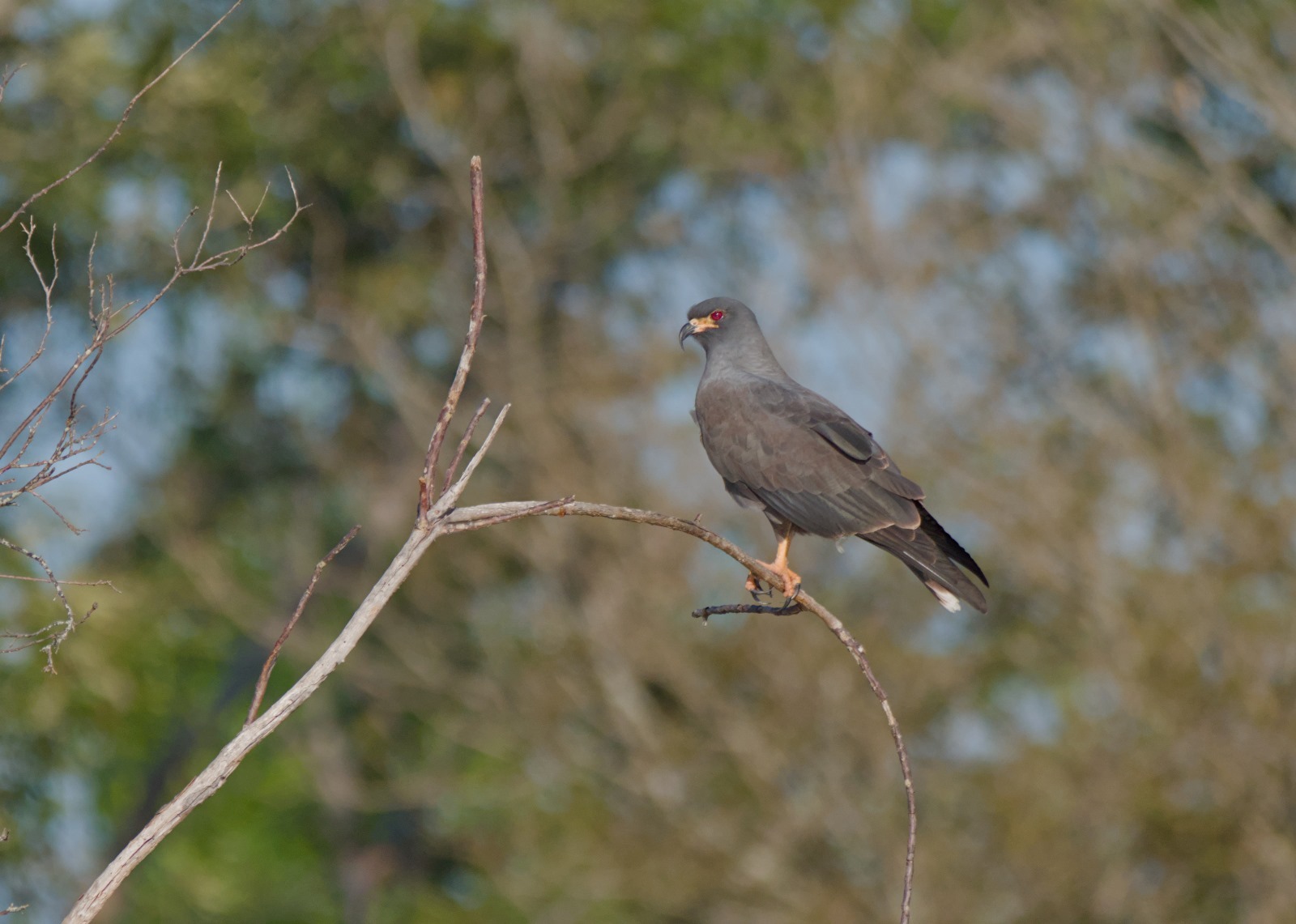
Snail Kite (Rostrhamus sociabilis). Photo by Blake Ross.
Day 2.
On day two, we decided to check a few birding spots on the coast to add to the trip list. So we left Mérida early and drove to Chuburná to bird all of the hotspots on the area before heading to Rio Lagartos around midday.
Highlights for Chuburna in the morning included: Black-throated Bobwhite, Common Ground Dove, Zenaida Dove, Mexican Sheartail, Cinnamon Hummingbird, Sanderling, Laughing Gull, Herring Gull, Lesser Black-backed Gull, Black Skimmer, Forster’s Tern, Sandwich Tern, Royal Tern, Magnificent Frigatebird, Osprey, Great Black Hawk, Zone-tailed Hawk, Crested Caracara, Common Tody-Flycatcher, Tropical Kingbird, Yucatan Gnatcatcher, Yucatan Wren, Savannah Sparrow, Hooded Oriole, Orange Oriole, Northern Parula, Yellow Warbler, Palm Warbler, Northern Cardinal.
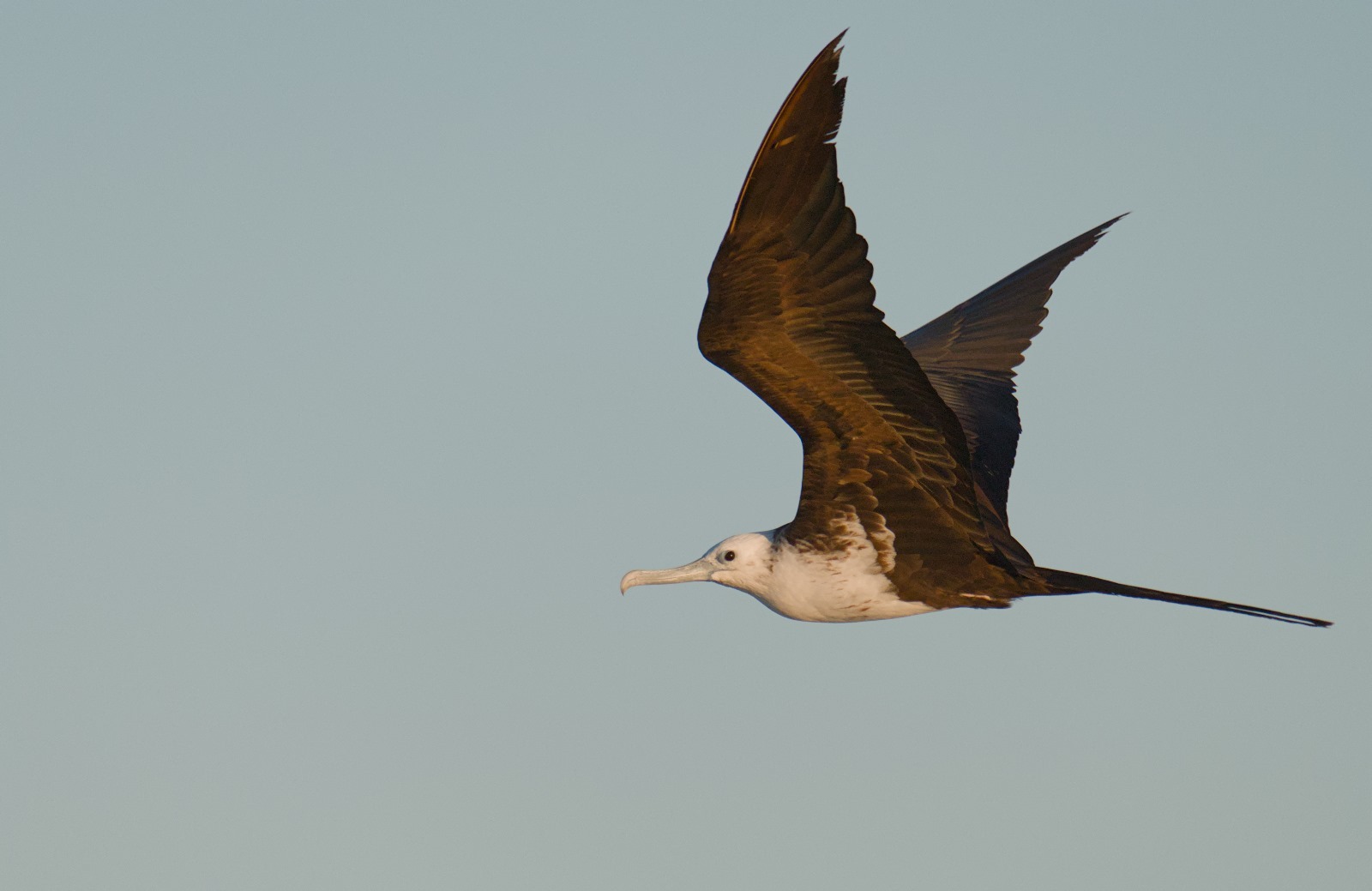
Magnificent Frigatebird (Fregata magnificens). Photo by Blake Ross.
Once we arrived in Rio Lagartos, we checked in at the Villa de Pescadores Hotel, dropped our stuff and got ready for a boat ride to try for Yucatan Nightjar and many other birds.
Our captain Chino picked us up at 3:30 PM right in front of our hotel and we started sailing across the mangrove forests of the reserve, many birds and crocodiles were seen. Some of the top birds for the boat ride included: Red-breasted Merganser, American Flamingo, Short-billed Dowitcher, Greater Yellowlegs, Ruddy Turnstone, Laughing Gull, Black Skimmer, Gull-billed Tern, Caspian Tern, Forster’s Tern, Royal Tern, Wood Stork, Anhinga, Bare-throated Tiger-Heron, Black-crowned Night Heron, Little Blue Heron, Tricolored Heron, Reddish Egret, Snowy Egret, Green Heron, Great Egret, Great Blue Heron (White morph), White Ibis, Roseate Spoonbill, Common Black Hawk, Belted Kingfisher, Laughing Gull, Peregrine Falcon, Olive-throated Parakeet, Mangrove Swallow, Northern Waterthrush, Mangrove Warbler.
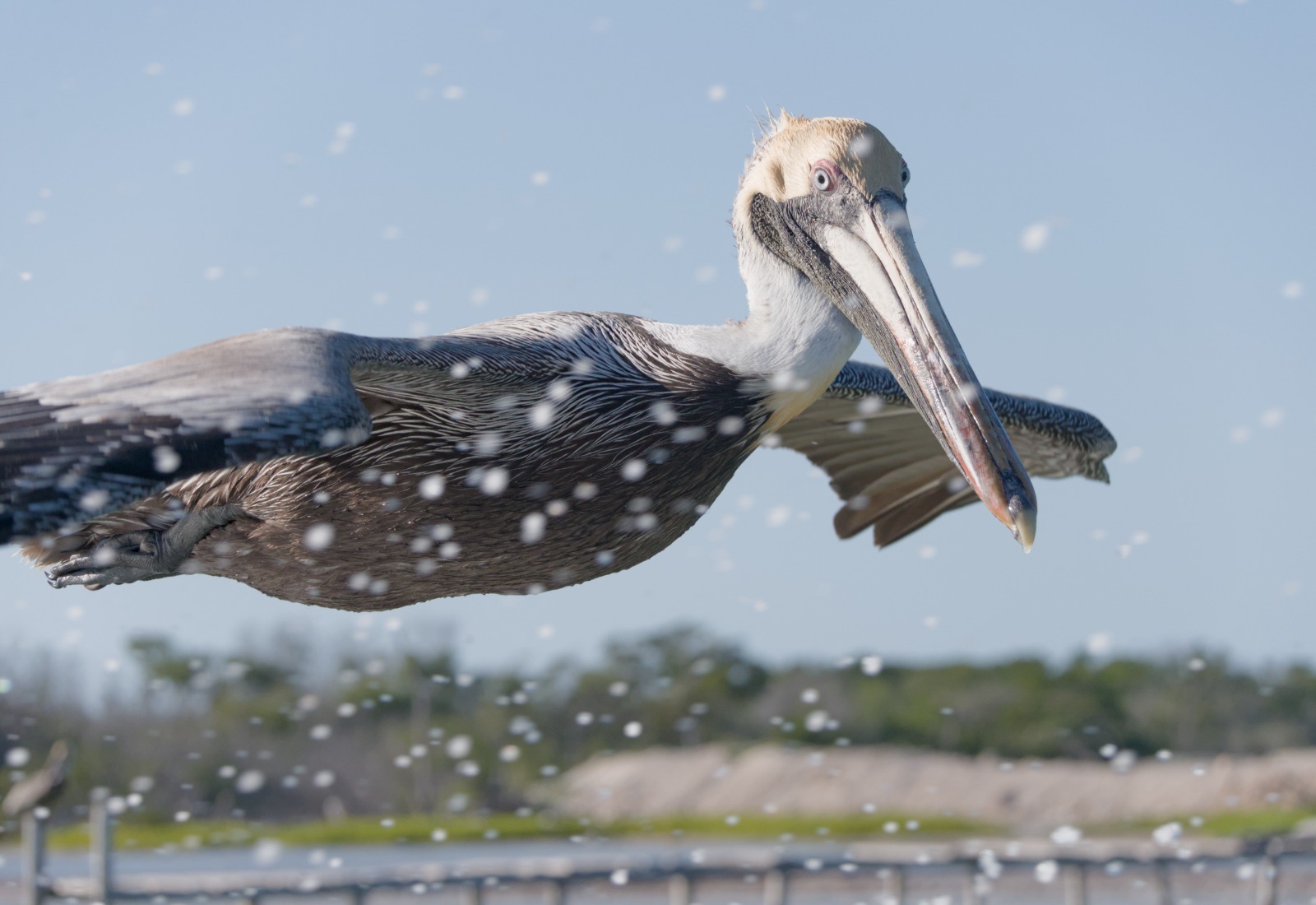
A very curious Brown Pelican (Pelecanus occidentalis) photographed during the boat ride in Rio Lagartos. Photo by Kent Ross.
When it got dark, we were able to spot three Yucatan Nightjars, a very difficult endemic.
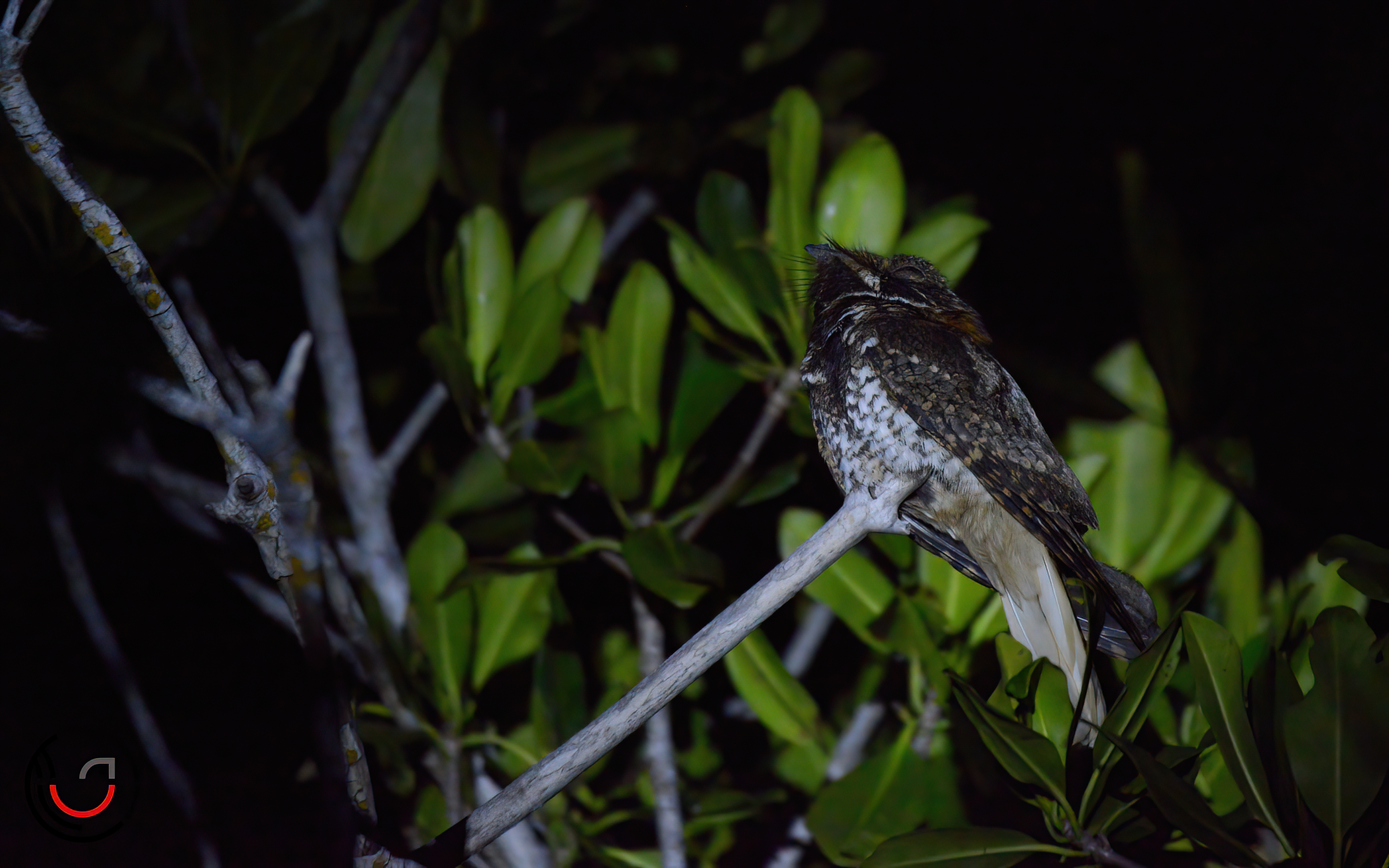
Yucatan Nightjar (Antrostomus badius) perched on a mangrove tree.
Day 3.
For our third day birding together, we went to one of Rio Lagartos’ best birding hotspots, the San Salvador Road where we spent a couple hours exploring the scrubs in the area. Highlights include: Blue-winged Teal, Plain Chachalaca, Black-throated Bobwhite, Red-billed Pigeon, White-tipped Dove, Canivet’s Emerald, Common Gallinule, Northern Jacana, Solitary Sandpiper, Least Sandpiper, Least Bittern, Little Blue Heron, Tricolored Heron, Glossy Ibis, Yucatan Woodpecker, Golden-fronted Woodpecker, White-fronted Parrot, Barred Antshrike, Rose-throated Becard, Rufous-browed Peppershrike, Green Jay, Yucatan Jay, Purple Martin, Yucatan Wren, White-bellied Wren, Yellow-breasted Chat, American Redstart, Common Yellowthroat, Northern Cardinal, Blue Grosbeak, Indigo Bunting, Painted Bunting, Blue-black Grassquit, Morelet’s Seedeater and Cinnamon-bellied Saltator.
After that, we visited a board walk to add a few species to the list and to get really close views of the Morelet’s Crocodile. Highlights from the boardwalk included: Russet-naped Wood-Rail, Common Black Hawk, American Pygmy Kingfisher, Lineated Woodpecker, Dusky-capped Flycatcher, Yellow-billed Cacique, Yellow-backed Oriole, Yellow-tailed Oriole, Melodious Blackbird, Northern Waterthrush, Hooded Warbler, Northern Parula, Magnolia Warbler and Yellow Warbler.
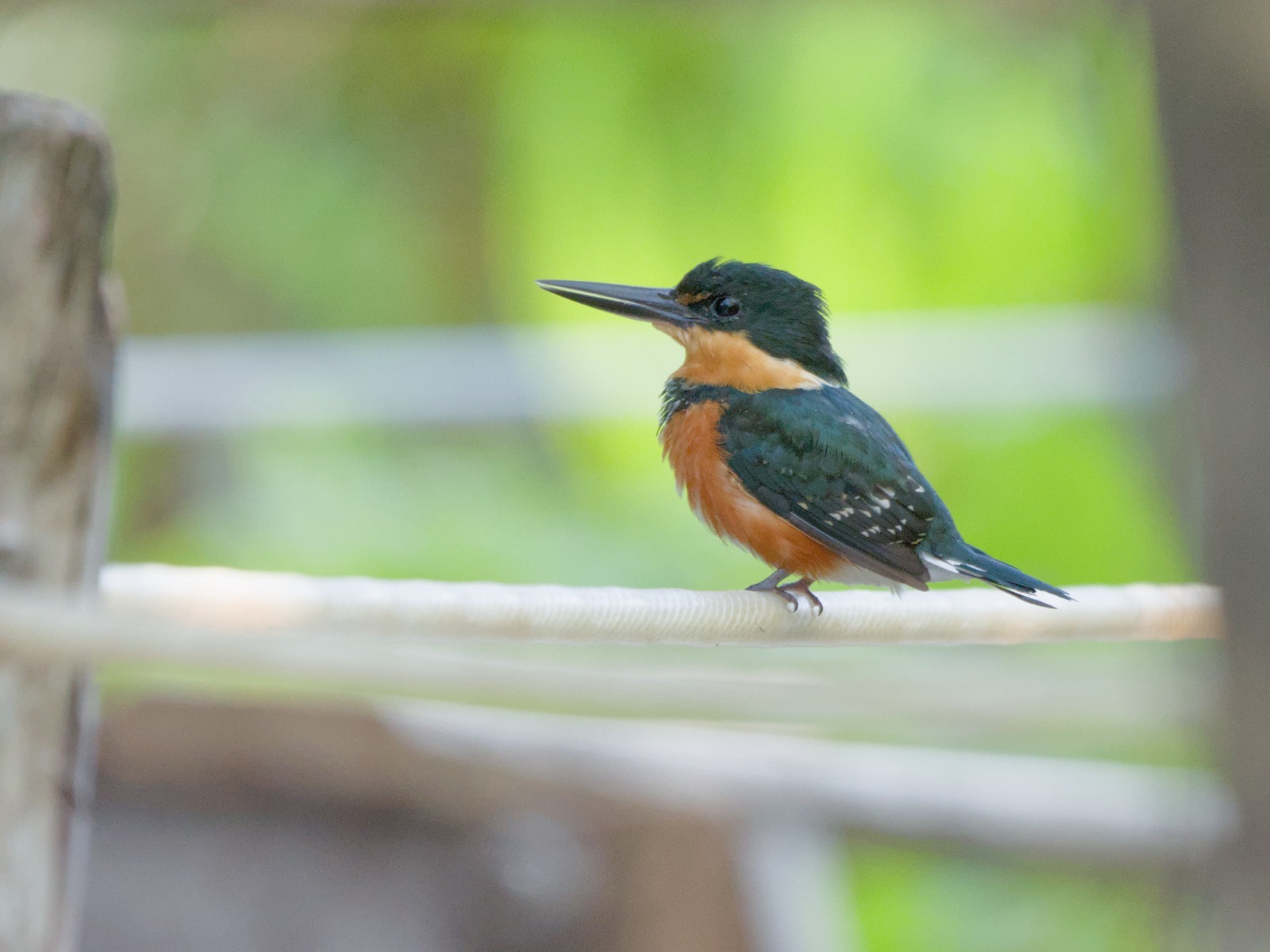
American Pygmy Kingfisher (Chloroceryle aenea). Photo by Kent Ross.
After birding around Rio Lagartos in the morning we headed towards Valladolid, checked in at our hotel and then, went birding again in the afternoon.
We visited a birding trail really close to the Amazili Nature Reserve, with a combination of crops and the edge of the semievergreen forest where we managed to see 52 species including: Plain Chachalaca, Red-billed Pigeon, Groove-billed Ani, Vaux’s Swift, Canivet’s Emerald, Buff-bellied Hummingbird, Roadside Hawk, Yucatan Woodpecker, Lineated Woodpecker, White-fronted Parrot, Yellow-lored Parrot, Northern Tropical Pewee, Least Flycatcher, Brown Jay, Green Jay, Yucatan Jay, Gray Catbird, Scrub Euphonia, Olive Sparrow, Black-cowled Oriole, Yellow-backed Oriole, Altamira Oriole, Hooded Warbler, Black-throated Green Warbler, Rose-throated Tanager, Gray-throated Chat, Indigo Bunting, Yellow-faced Grassquit and Black-headed Saltator.
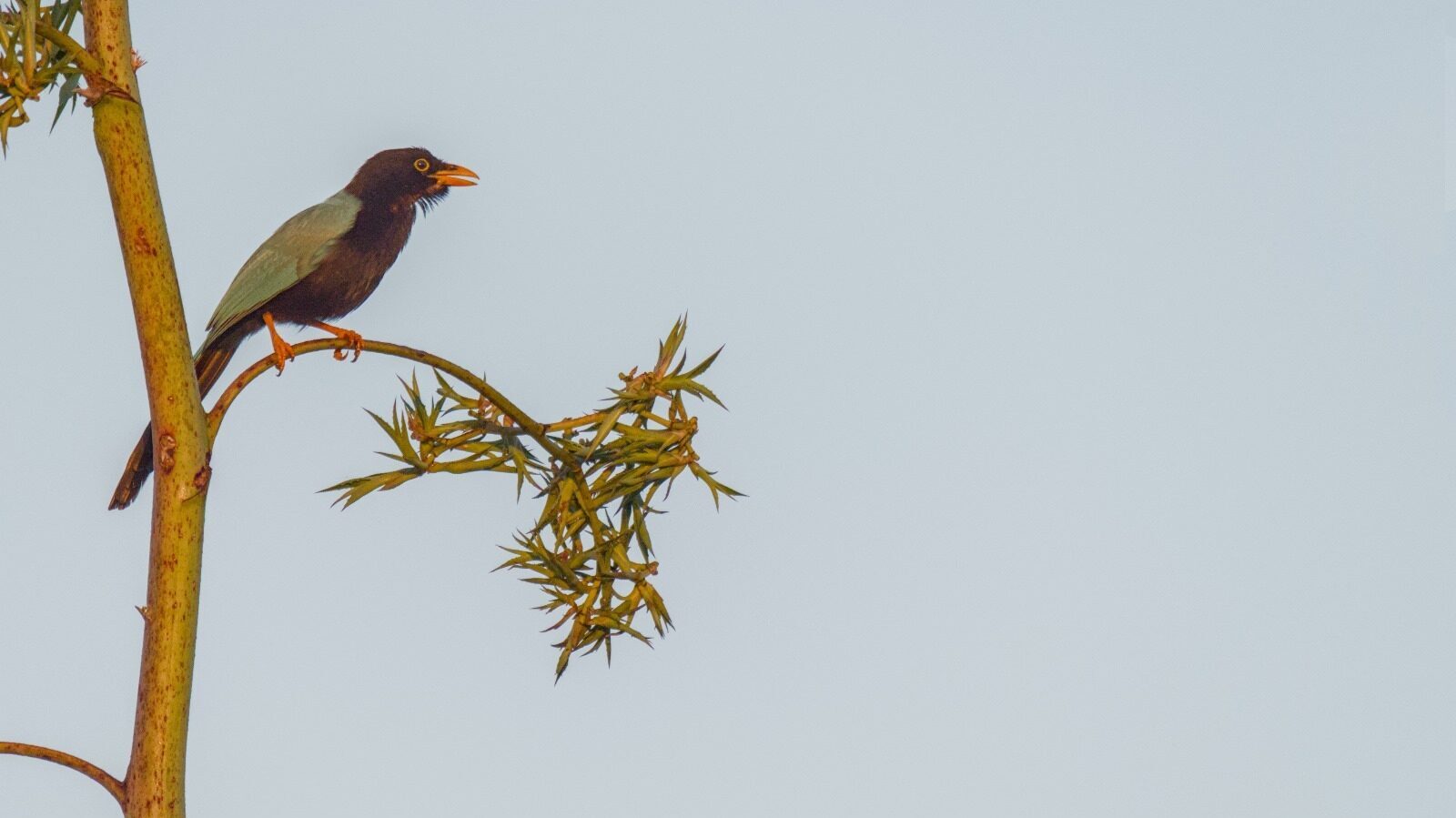
Yucatan Jay (Cyanocorax yucatanicus). Photo by Blake Ross.
Day 4.
For our fourth day, we left Valladolid around 4 AM in the morning to drive towards a private reserve in Felipe Carrillo Puerto. This reserve is close to the water and the vegetation is taller and more humid than in the previous location we visited, so this of course, produces different bird species. First, we birded the “Reserva Ejidal Much Kanan K’aax” getting a total of 53 species including: Caribbean Dove, Canivet’s Emerald, Wedge-tailed Sabrewing, White-bellied Emerald, Gray-headed Kite, Ferruginous Pygmy-Owl, Black-headed Trogon, Gartered Trogon, Turquoise-browed Motmot, Collared Aracari, Keel-billed Toucan, Lineated Woodpecker, Olive-throated Parakeet, Ruddy Woodcreeper, Tawny-winged Woodcreeper, Ivory-billed Woodcreeper, Masked Tityra, Stub-tailed Spadebill, Northern Bentbill, Yellow-olive Flatbill, Greenish Elaenia, Yucatan Flycatcher, Tawny-crowned Greenlet, Lesser Greenlet, Mangrove Vireo, Brown Jay, Carolina Wren, Spot-breasted Wren, Green-backed Sparrow, Black-and-white Warbler, American Redstart, Rose-throated Tanager and Red-crowned Ant-Tanager.
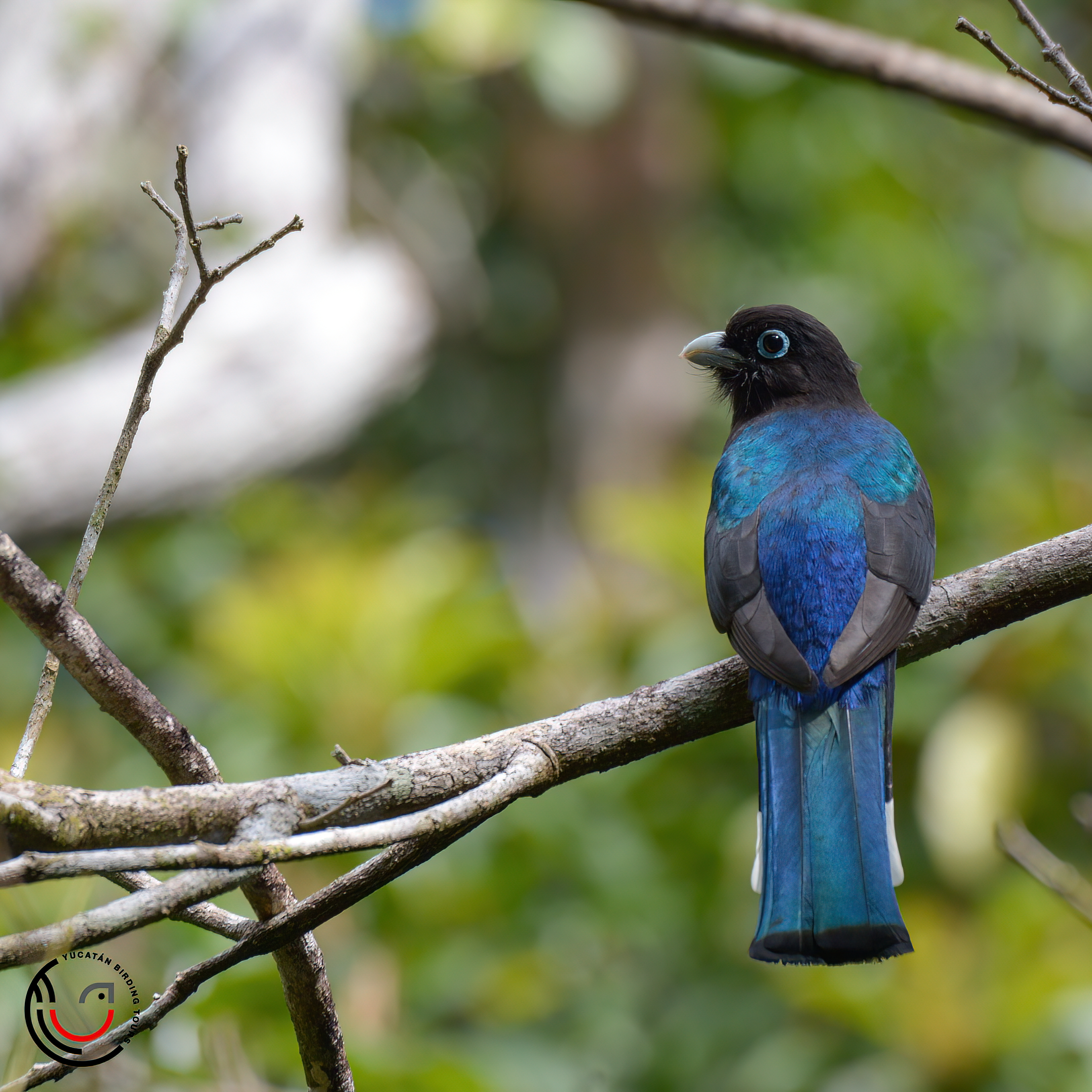
Black-headed Trogon (Trogon melanocephalus).
After that, we visited the “Siijil Noh Ha” reserve, where we checked the camp and the lagoon. Highlights included: White-bellied Emerald, Neotropic Cormorant, Black Vulture, Black-headed Trogon, Gartered Trogon, Keel-billed Toucan, Olive-throated Parakeet, Great-crested Flycatcher, Lesser Greenlet, Mangrove Swallow, Scrub Euphonia, American Redstart, Magnolia Warbler, Rose-throated Tanager and Red-legged Honeycreeper.
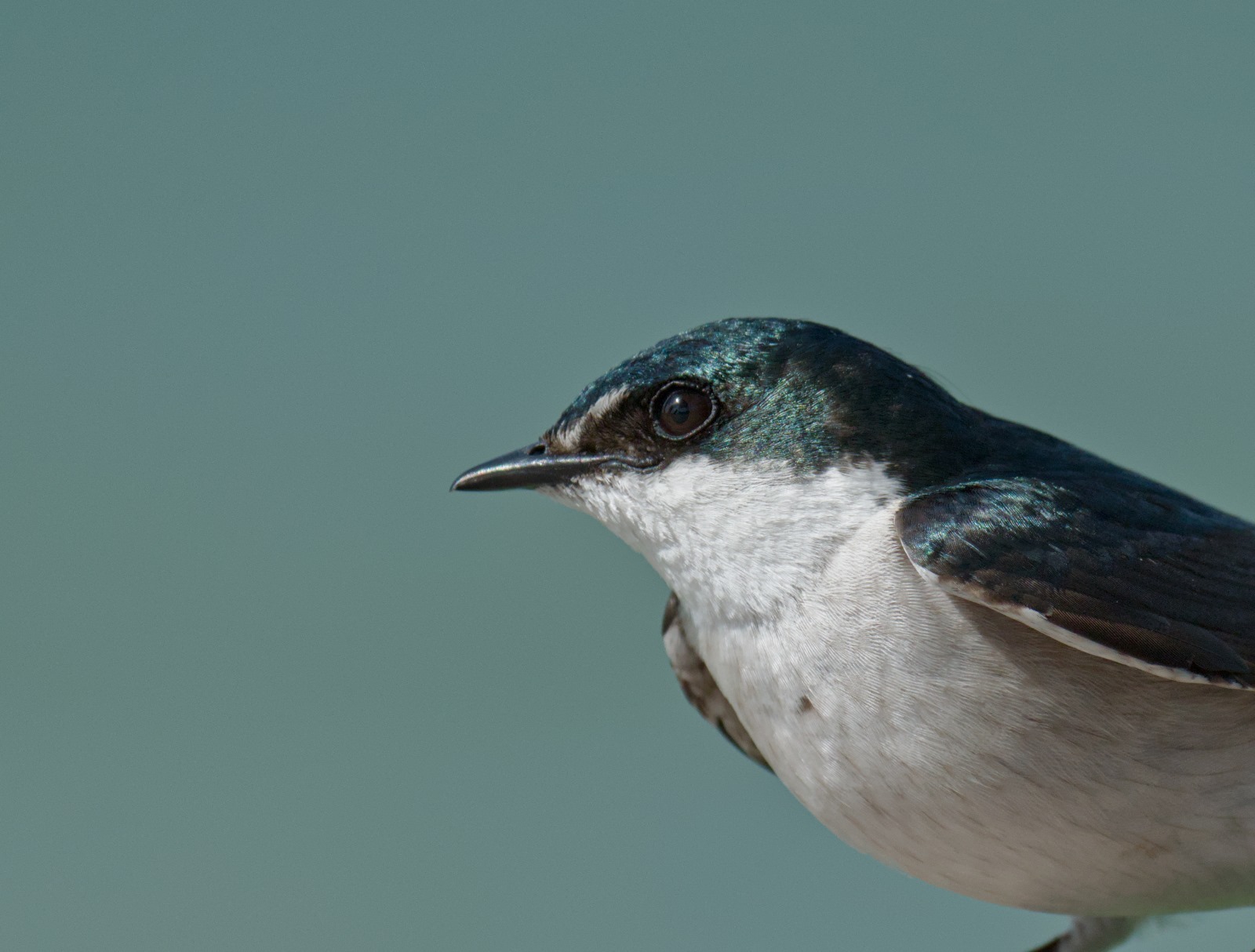
Mangrove Swallow (Tachycineta albilinea). Photo by Blake Ross.
On the way back to the main road, we came across an ant swarm! This is one of the best things that can happen to you when you’re birdwatching in the tropics, as many skulky birds follow the army ants to eat all of the insects, spiders and other critters that are trying to escape from the ants and this often produces superb views of many species. This one, wasn’t the exception, we stayed pretty much sitting still on the ground for about 2 hours, just looking at the birds feeding from up close and taking some wonderful pictures. Highlights included: Lesson’s Motmot, Olivaceus Woodcreeper, Ruddy Woodcreeper, Tawny-winged Woodcreeper, Northern Barred-Woodcreeper, Ivory-billed Woodcreeper, Eye-ringed Flatbill, White-bellied Wren, Wood Thrush, Black-and-white Warbler, Hooded Warbler, Red-crowned Ant-Tanager, Red-throated Ant-Tanager and Gray-throated Chat.
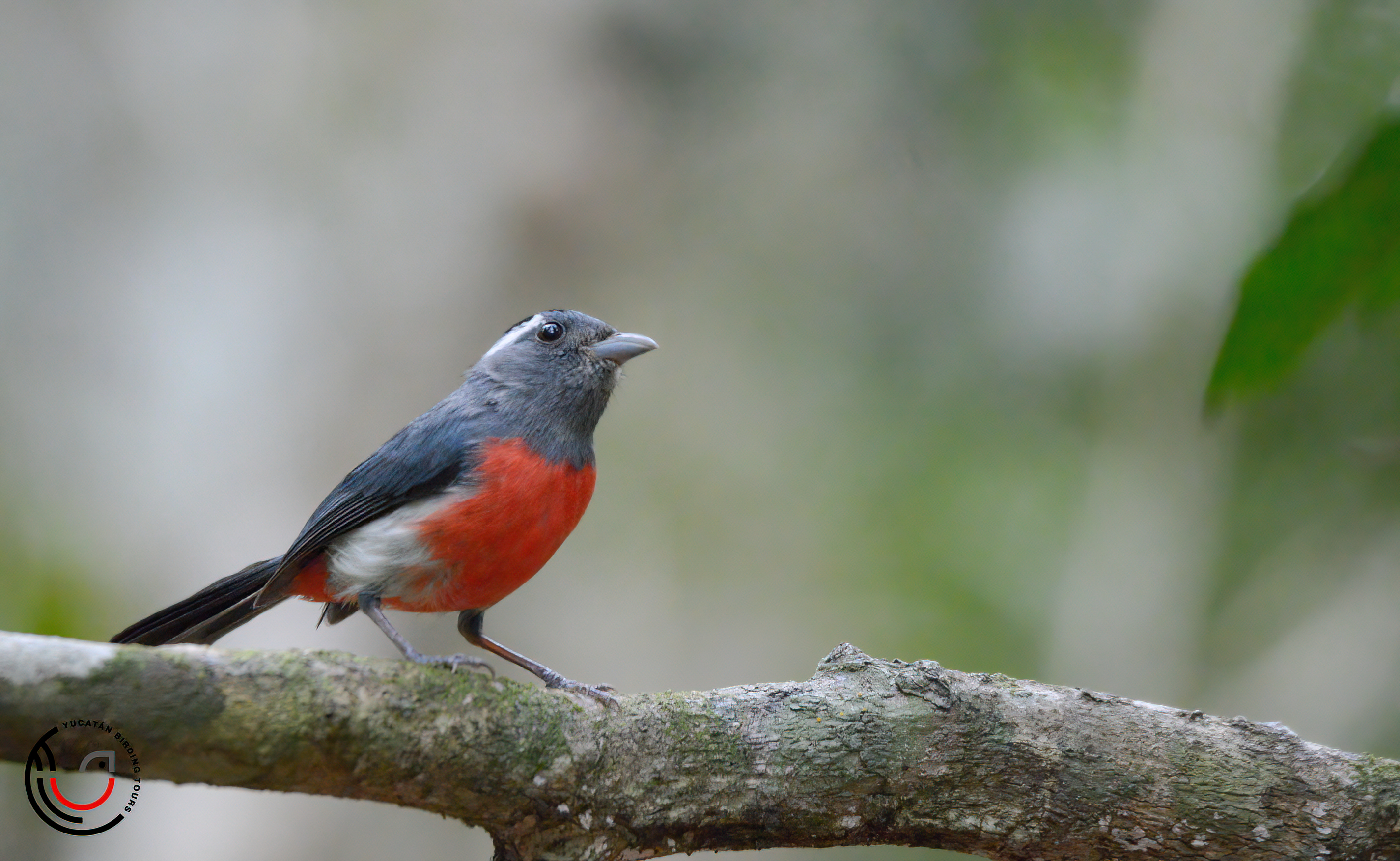
A male Gray-throated Chat (Granatellus sallaei) posing nicely for pictures while feeding on the ant swarm.
We left Felipe Carrillo Puerto and started making our way to Bacalar. Our luck continued as all along the road, we spotted about 10 different White-necked Puffbirds sitting on the powerlines!
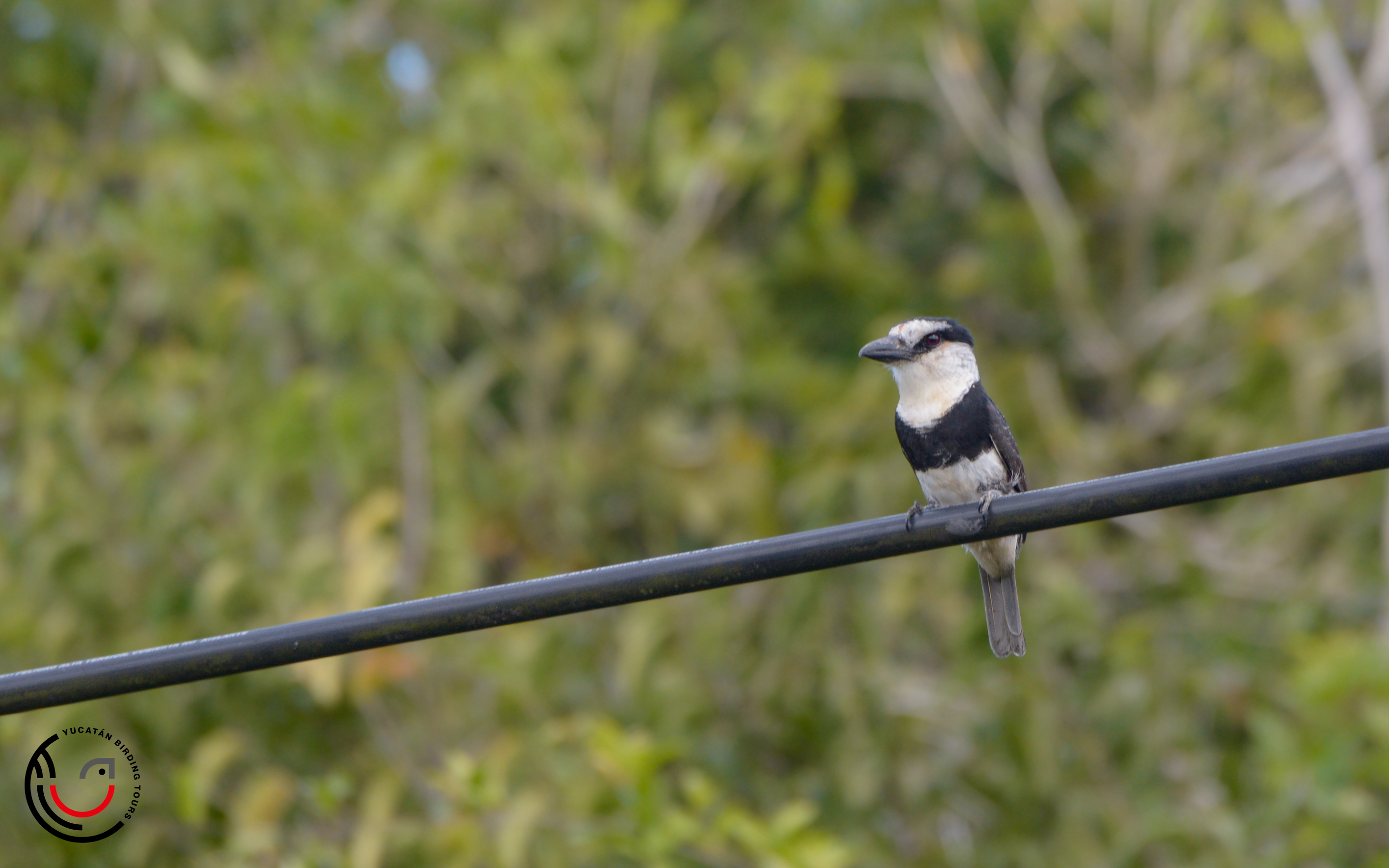
White-necked Puffbird (Notharchus hyperrhynchus) perched on a powerline in Felipe Carrillo Puerto.
Once in Bacalar, we took a relaxed afternoon with some easy birding at our hotel right in front of the lagoon. Some of the birds that we were able to see included Lesser Scaup, Royal Tern, Neotropic Cormorant, Snail Kite, Peregrine Falcon, Social Flycatcher and Brown Jay.
Day 5.
For our last day together, we visited the Kohunlich ruins, this remote archaeological site is always a highlight on all of our birding tours as this place is not only beautiful but also very productive. Before actually heading into the ruins, we birded along the road that takes you to them where we managed to see 41 species including: Scaled Pigeon, Red-billed Pigeon, Blue Ground Dove, Squirrel Cuckoo, Ruby-throated Hummingbird, Canivet’s Emerald, Rufous-tailed Hummingbird, Roadside Hawk, Gray Hawk, Ferruginous Pygmy-Owl, Black-headed Trogon, Gartered Trogon, White-crowned Parrot, Olive-throated Parakeet, Northern Bentbill, Yellow-olive Flatbill, Yellow-bellied Flycatcher, Bright-rumped Attila, Clay-colored Thrush, Green-backed Sparrow, Louisiana Waterthrush, Red-throated Ant-Tanager and Gray-headed Tanager.
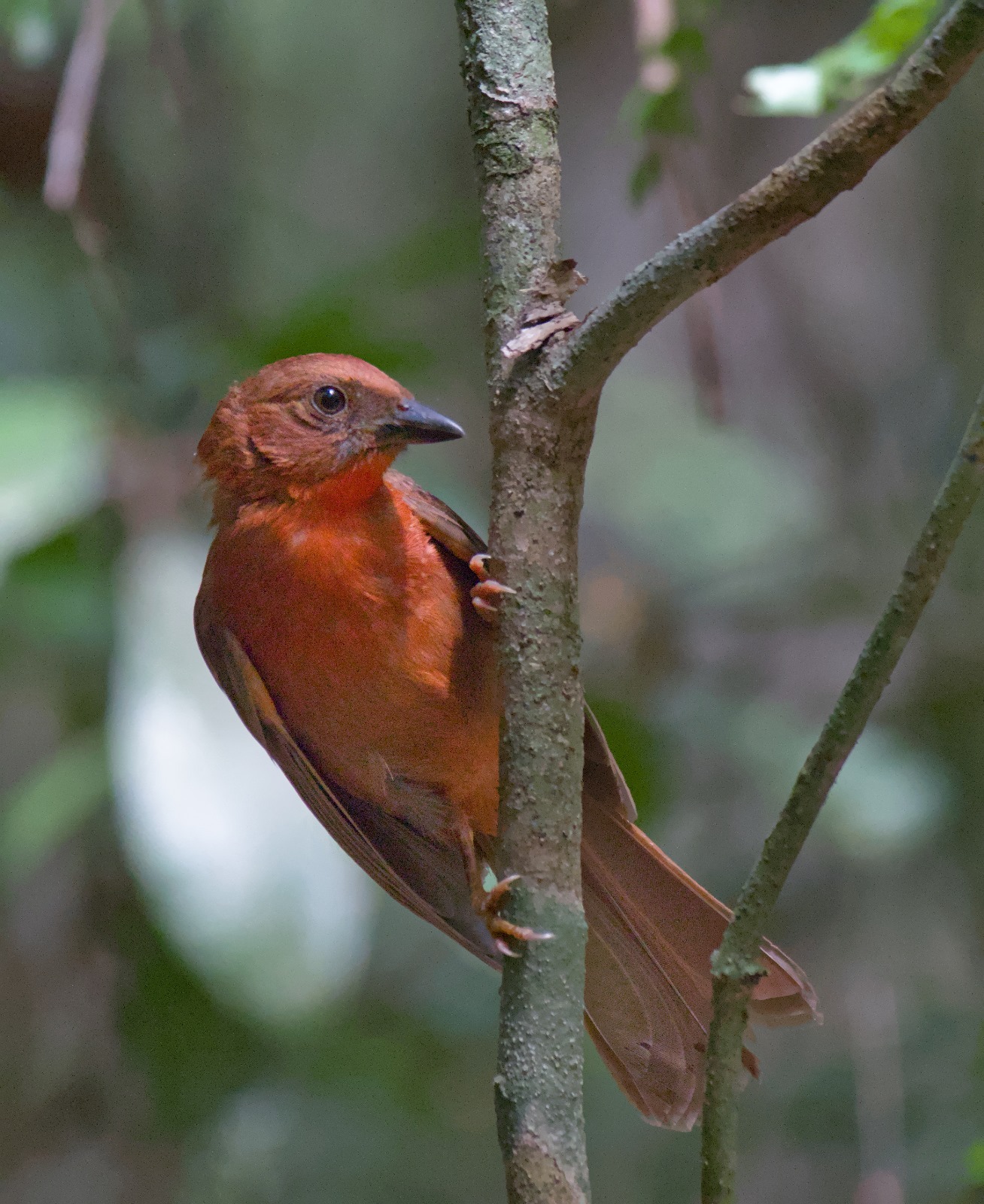
Red-throated Ant-Tanager (Habia fuscicauda). Photo by Blake Ross.
Once inside the ruins, we started slowly walking around the place. This archaeological site is pretty much the only one of it’s kind in the Peninsula with a special kind of palm tree that is one of the most (if not the most) dominant species of tree in the area. We were the only people in the ruins besides the employees working there and we saw 48 species of birds, some of the top birds included: Rufous-tailed Hummingbird, White-bellied Emerald, Swallow-tailed Kite, Roadside Hawk, Black-headed Trogon, Pale-billed Woodpecker, Chestnut-colored Woodpecker, Bat Falcon, White-crowned Parrot, White-fronted Parrot, Red-capped Manakin, Masked Tityra, Ochre-bellied Flycatcher, Tawny-crowned Greenlet, Lesser Greenlet, White-breasted Wood-Wren, Yellow-throated Euphonia, Black-and-white Warbler, Hooded Warbler, American Redstart, Northern Parula, Magnolia Warbler, Yellow-throated Warbler, Black-throated Green Warbler, Summer Tanager, Western Tanager and Red-throated Ant-Tanager.
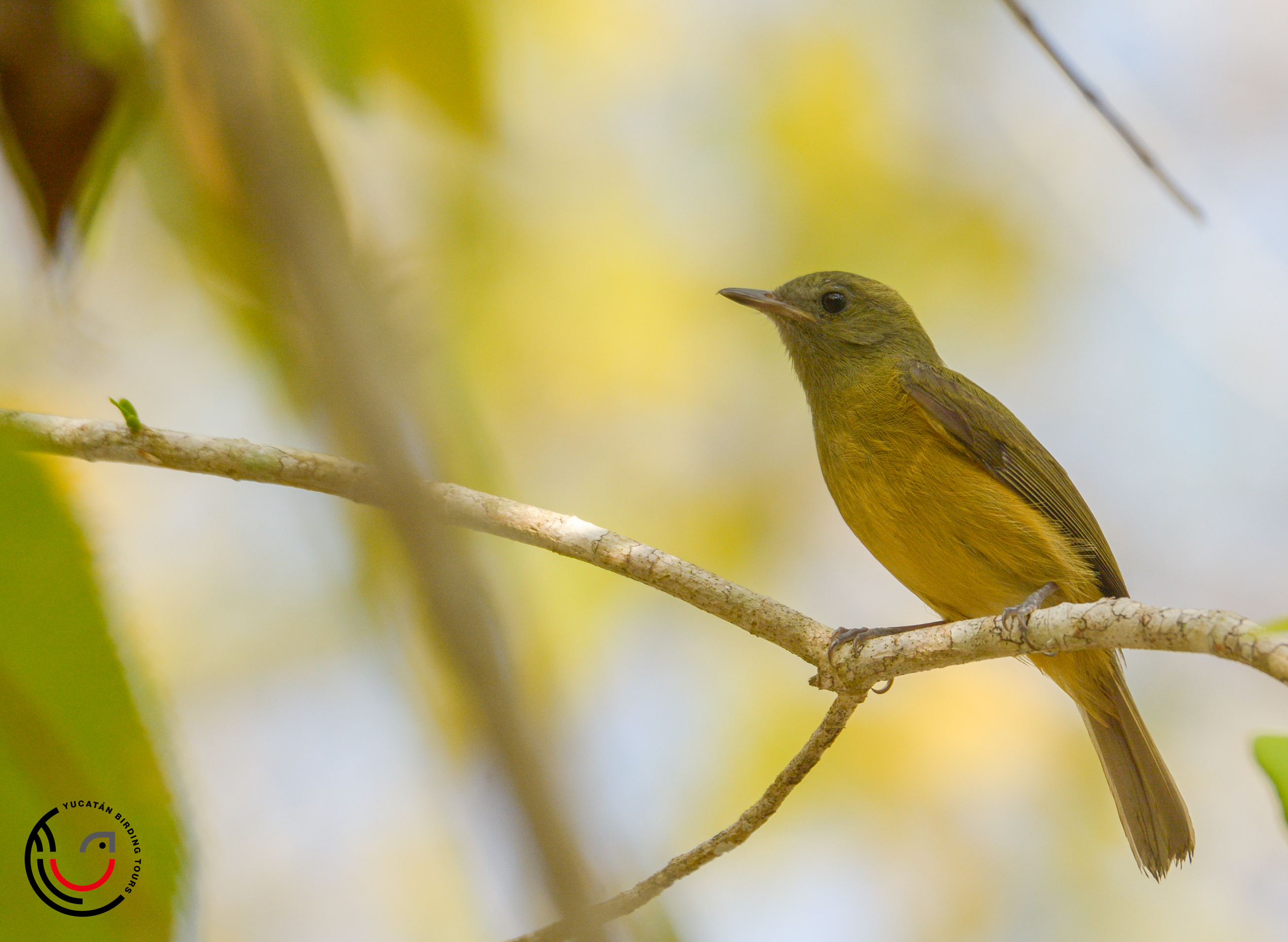
Ochre-bellied Flycatcher (Mionectes oleagineus) photographed at the Kohunlich Archaeological Site.
This represented the end of our trip together, as after this we dropped Kent and Blake at the bus station in Bacalar for them to get to Cozumel Island for an extra day with our local guide.
We saw a total of 230 species and both Kent and Blake had 150+ lifers during this trip.
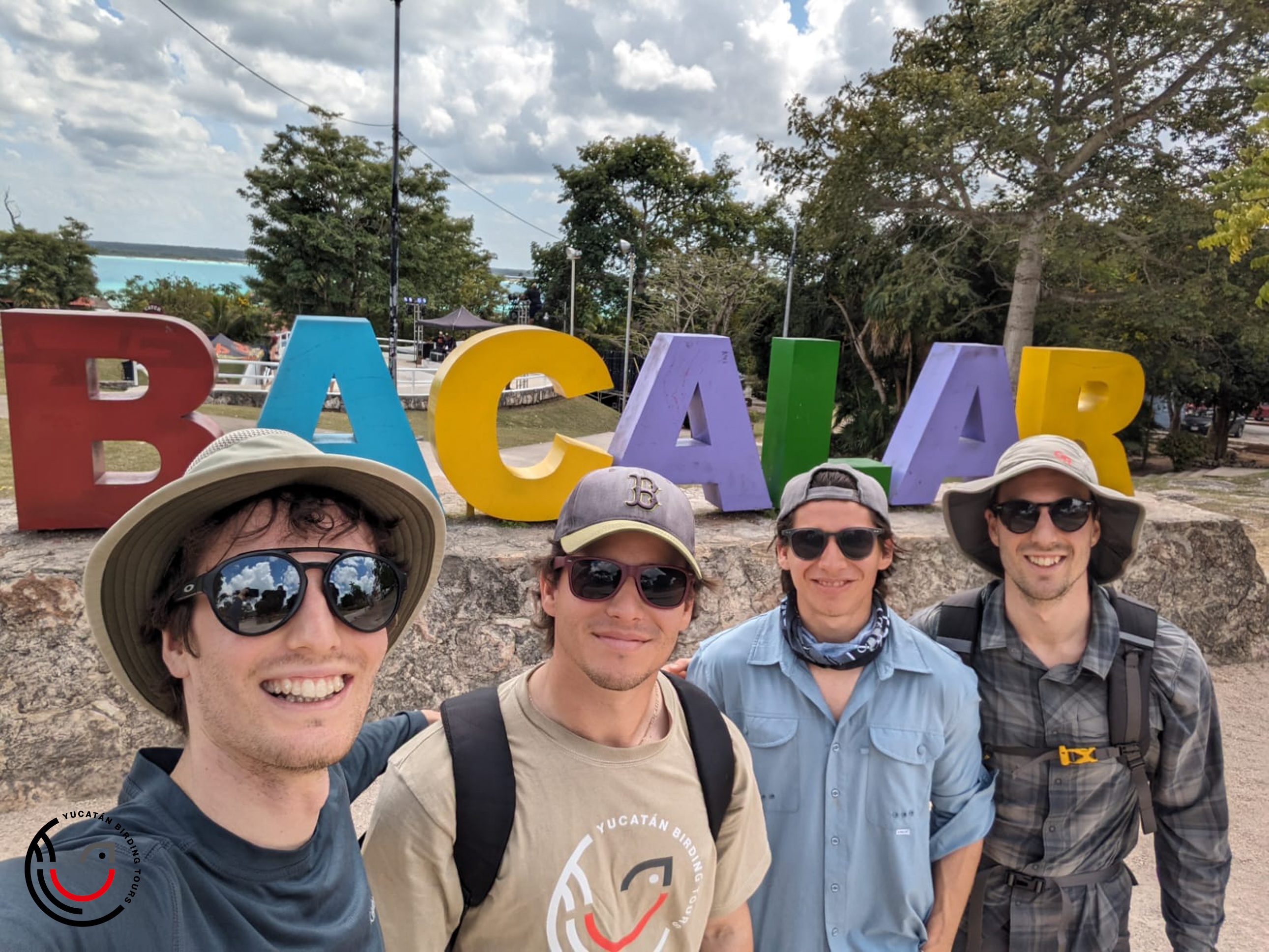
Group photo at the end of the tour!
List of mammals seen: Common Raccoon, Yucatán Squirrel, Central American Agouti.
List of reptiles seen: Morelet’s Crocodile, Black Spiny-tailed Iguana, Cozumel Spiny Lizard, Brown Anole, Asian House Gecko, Brown Basilisk.
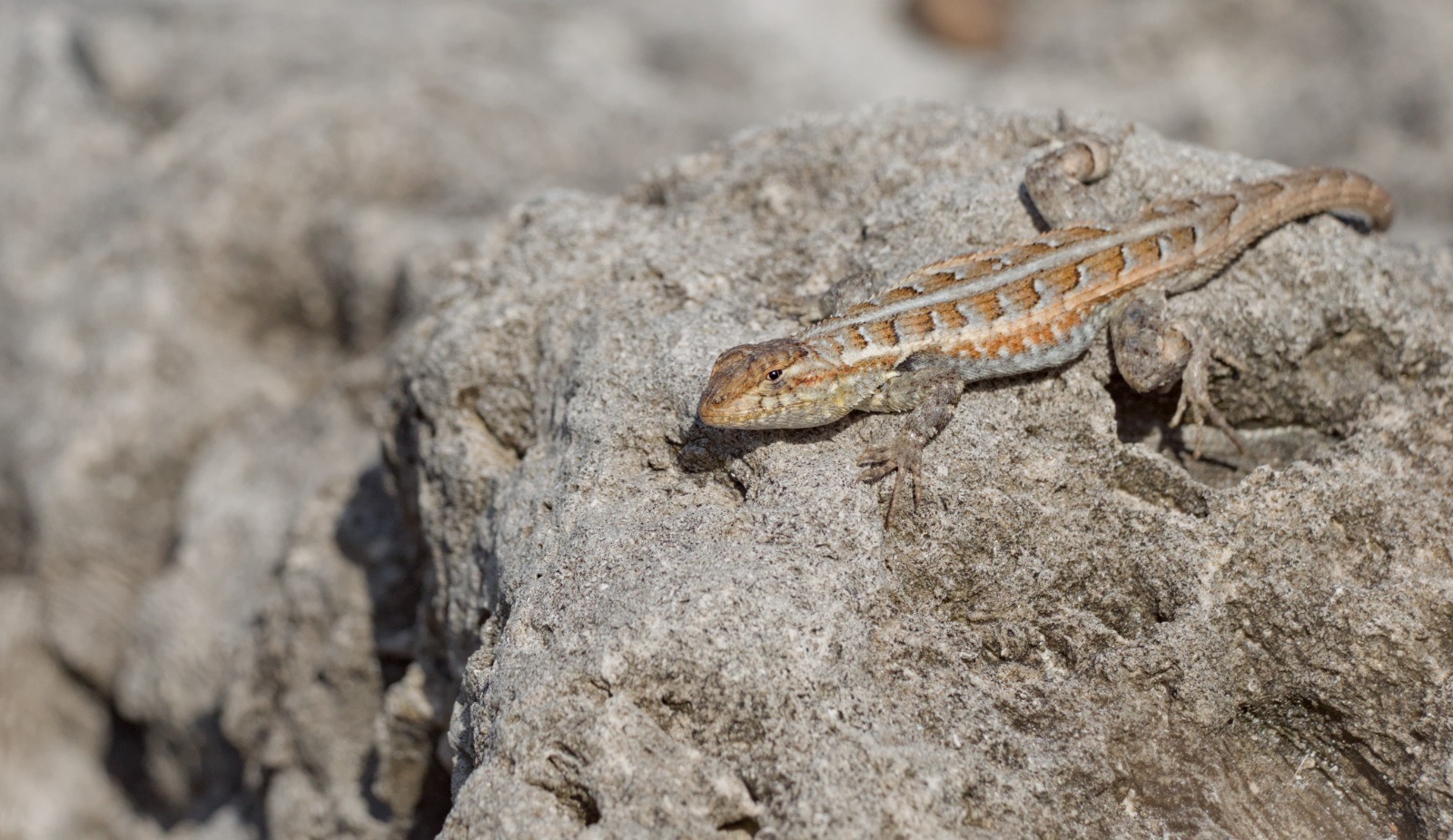
Cozumel Spiny Lizard (Sceloporus cozumelae) an endemic species.
Written by Luis Trinchan Guerra





